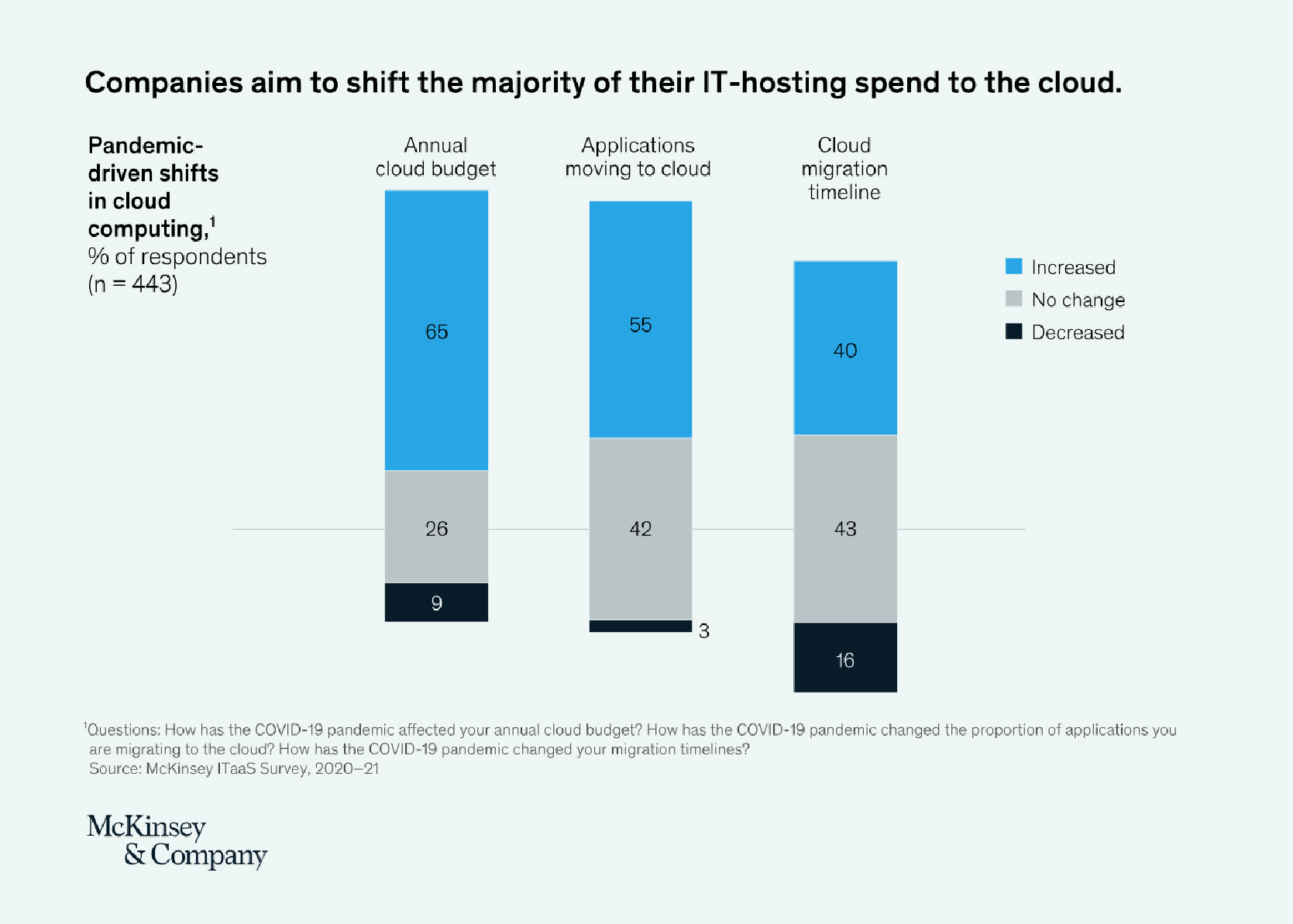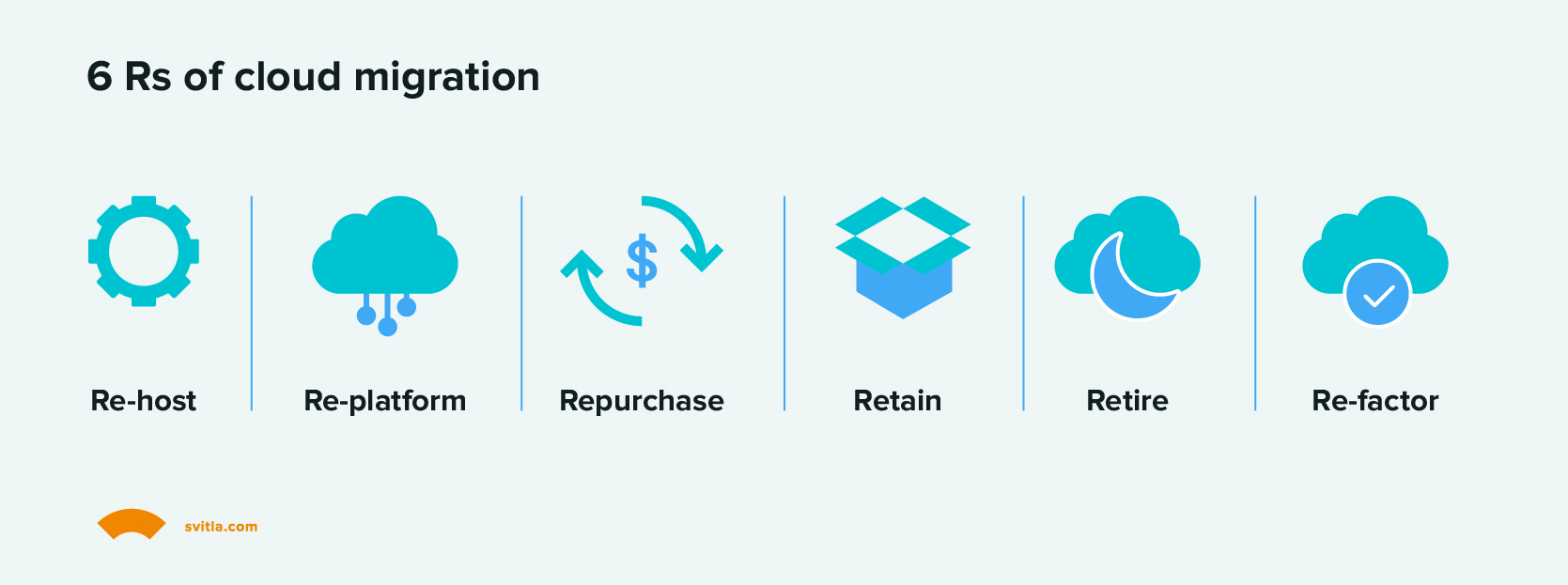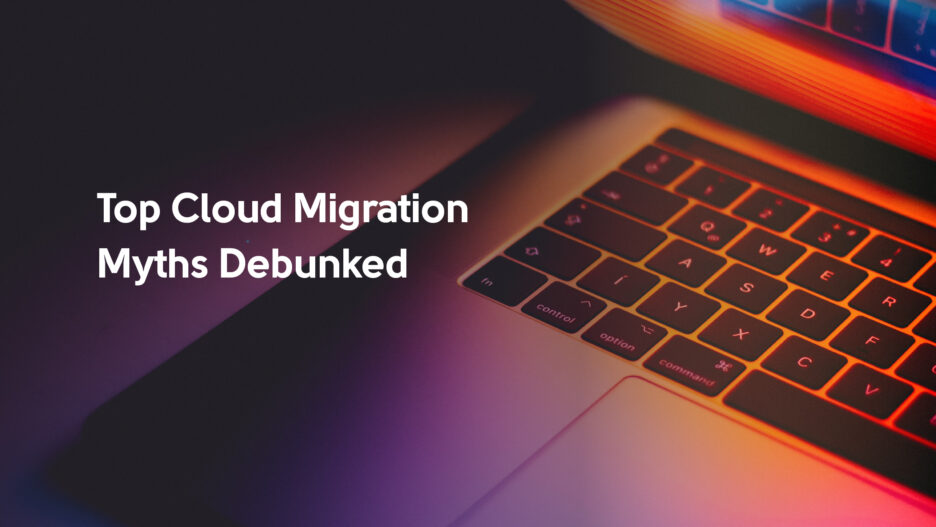Cloud benefits have been hyped a lot. But the cloud isn’t a “magic bullet” solution. Lower total cost of ownership (TCO), higher system performance, and improved security aren’t guaranteed factors — they result from a diligently planned and executed cloud adoption strategy.
This creates some unhealthy expectations, which then turn into budget overruns, project delays, and lackluster ROI.
To set the record straight, we’ve addressed some of the biggest, most misleading cloud computing myths.
Top 7 Cloud Migration and Cloud Operations Myths, Busted
Whether you’re looking for some solid arguments to counter the current concerns around cloud adoption or want to set clear expectations for cloud migration outcomes, here are some good talking points to bring up.
Myth #1: You Can Just Re-Assign Current IT Staff To Cloud Duty
You have an IT department supporting on-premises assets. So they might as well support new cloud environments and help with migration. Not quite.
Only 39% of organizations rate their IT staff as "very capable" of cloud implementation, management, and operations.
– S&P Global
Cloud architecture and cloud-native workloads are similar, but not the same as on-premises. System architecture, process design, and application development practices differ a lot. Most IT teams often lack the skills to support, let alone, design and implement cloud-native solutions. In fact, 95% of companies name “lack of cloud talent and expertise” as the biggest barrier to cloud adoption, a McKinsey survey found.
Cloud architecture differs from on-premises system deployments. To benefit from the cloud, a simple "lift and shift" strategy of virtualizing assets and re-hosting them in the cloud won’t be enough.
On-premises systems will need to be re-optimized for the cloud to benefit from native features such as auto-scaling, automated performance management, or granular IAM and authentication controls. Likewise, you’ll need to adjust your network settings, data storage infrastructure, and security monitoring to include new cloud assets.
To successfully execute a cloud adoption project, you will require the following roles:
| Migration | Operations |
|
Solution architects Business analysis Cloud engineers DevOps specialists |
Network engineers System administrators SRE / DevOps specialists |
The big question is: Where do you find these people?
The average company has around 35% of qualified cloud personnel in-house, with most acquiring cloud talent through third parties such as managed cloud services providers.

Myth #2: Cloud Services Are Always More Affordable
Сloud services' affordability is one of the common myths about cloud computing. On the surface, cloud computing eliminates substantial CAPEX costs of on-premises data centers.
In practice, many businesses are rapidly disillusioned by cloud “affordability”. The Wall Street Journal recently commented on how companies are routinely surprised by the cloud bills and cannot fully justify the cost increases to other stakeholders. A 2022 survey by Andot mirrors these findings: 50% of surveyed companies struggle to control cloud costs due to pervasive resource wastage, immature cloud architecture, low visibility into cloud workloads, and duplicate resource deployments.
Pay-per-use cloud pricing models often prove to be a blessing in disguise. Offering a low-cost, fast start, cloud computing costs compound as the usage grows and can reach soaring heights. Cloud migration costs also prove to be substantial, with companies spending as much as 75% on top of the planned budget.
The total cost of ownership (TCO) of the cloud depends on multiple factors, including:
- Type of migrated systems
- Migration strategy
- Labor costs
- Cloud administration controls
Although companies can achieve cost savings from cloud adoption, the cloud ROI extends well beyond cost savings. Cloud technologies increase operational agility and resilience, often resulting in wider business model transformations and access to new revenue pools.
In the case of our client, Mueller Water Products, cloud migration resulted in a significant improvement in team productivity, lower support costs, and elevated user experience.
Read more about how to calculate the ROI of moving to the cloud.
Myth #3: Cloud Migration is a One-Off Event
We bet you’ve heard this cloud migration myth at least once.
“We’ll migrate in several months, and call it a day”, some board members might think. That’s rarely the case.
Few cloud migration projects follow a big-bang approach — a one-time transfer of all data, workloads, and applications from on-premises to newly set environments. Instead, most opt for a more sustainable “trickle” approach of sequential migration of different systems, followed by a round of extensive system testing, fine-tuning, and optimization.
Cloud migration timelines also vary based on the application migration approach.

Let’s consider some of the 6Rs of cloud migration.
Re-hosting (also known as lift and shift) allows to migrate a large number of assets without worrying about long cutover windows, time-consuming data replication, or performance disruptions. Re-hosting applications in the cloud is cheaper and faster than re-factoring them, but this approach is mostly focused on changing the application storage from local to cloud and doesn’t let you immediately profit from more cloud-native services.
Other downsides of re-hosting are:
- Potentially high cloud costs due to unsuitable application architectures and inability to use cloud-native performance optimization tools.
- Higher latency as migrated apps don’t support auto-scaling.
- Post-migration complexities when you overlook certain dependencies between the re-hosted apps and on-premises infrastructure.
Re-platforming (also known as lift and reshape) assumes a certain degree of optimization before migration to optimize application performance, reduce costs, or take advantage of cloud capabilities. For example, you might re-platform an on-premises PostgreSQL database to Amazon RDS – a cloud-native relational database service for SQL querying.
This is a strong “middle ground” between migrating assets as-is and fully re-engineering an application. The key is avoiding “scope creep” i.e., settling for “good enough” configurations to migrate faster instead of making too many changes, which would bring the project into re-factoring territory. Once your applications are running in the cloud, you can make further changes and optimizations.
Refactoring is the most labor- and cost-intensive cloud migration strategy. But it also generates the most end-value. In this case, you modify the migrated app architecture to take full advantage of the cloud-native features. For example, change the app architecture from monolith to microservices.
Refactoring makes sense when a legacy app is:
- Expensive to maintain due to legacy code
- Lagging in performance and cannot be scaled
- Difficult or impossible to test with automation methods
- Hindering modernization efforts of other products
By structurally changing the application, you can achieve greater cost efficiency in the short term and set a better base for long-term growth.
Take it from Airbnb. Originally, the Airbnb app was designed as a monolith Ruby-on-Rails application. Such an approach made sense when Airbnb was a scrappy startup. But as their user base and engineering task force kept growing, the monolith became a major hindrance.
In 2018, Airbnb began migrating its tech stack from monolith to service-oriented architecture (SOA). The team decomposed the original platform into loosely coupled services. Each service can be deployed and scaled independently. Ownership within a service is more clear because it's defined in the API. Requests to these services can be made in parallel.
By progressively re-factoring the app into some 250+ services, Airbnb went from handling over 3,000 new code deployments per week to 10,000+. The new system architecture also reduces latency. For example, the search page started working 3X faster, and the home description page — 10X faster. The overall system stability also improved substantially.
Although platform re-factoring took Airbnb over 4 years to execute, the commitment brought substantial dividends.
Myth #4: Cloud Migration is Always Complex and Disruptive
Cloud migration can, but shouldn’t be complex. At the surface level, there are a lot of “moving parts” — an initial assessment of available assets, selection of the migration strategy, cloud storage systems design, security and infrastructure monitoring implementation among other actions.
All of these should be organized on your cloud migration roadmap — a strategic document, outlining your business case, objectives, and approaches to cloud adoption.
Your initial roadmap doesn’t have to span over your entire infrastructure and document the goals for the next 5 to 10 years. Start smaller.
As a cloud solutions development partner, we always recommend our clients take a sequential approach to cloud migration. Start with several pilots — a set of pre-qualified apps or workloads to serve as proof of concept (PoC).
By migrating a small portfolio of applications, you can secure some “quick wins” and collect metrics to justify cloud ROI for more complex projects. PoCs also help polish your processes and frameworks to emerge better prepared for the next phase.
Myth #5: Cloud Increases Data Security Risks
Low public cloud security is one of the longest-living cloud computing myths. But it's deeply rooted in the misunderstanding of the cloud security model.
CSPs practice a “shared responsibility security model”. Each provider continuously invests in hardening its physical infrastructure and virtual assets. Most employ best-in-class cybersecurity talent to develop and maintain the security of their solutions and develop new security tools for customers. AWS, for example, has 300+ cloud security tools.
The wrinkle? Cloud security hinges on the companies’ diligence in implementing recommended security controls and configurations — and many fall short in this department.
Through 2025, 99% of cloud security failures will be the customer’s fault.
– Gartner
The highly publicized cloud security breaches were driven by poor security configurations on the customers’ side. Pegasus Airlines was hacked in 2022 because it stored over 6.5 TB of customer data in an unsecured cloud storage location.
Businesses are responsible for exerting proper security controls in the cloud. You should implement clear policies on data storage, implement proper access and identity (IAM) controls, secure all endpoints, and implement cloud security monitoring to ensure ongoing compliance with the corporate security requirements and regulatory policies.
Myth #6: Cloud Services Are Only Suitable For Enterprises
Multinational enterprises often make the bulk of cloud migration case studies. But they aren’t the only ones with high cloud aspirations.
According to Flexera, 53% of small and mid-sized businesses (SMBs) are now spending over $1.2 million annually on the cloud, which indicates high adoption levels.
Unlike larger enterprises, SMBs don’t carry the burden of a bloated technical estate and legacy applications. In fact, many choose cloud as their main “playing field” and commit to cloud-native operations from day one. An IDC report found that SMBs, operating in the cloud, have 36% lower operational costs, 41% more efficient IT teams, and 26% lower IT infrastructure costs.
Moreover, the cloud majorly accelerated new product development. Startups and scale-ups can test new ideas faster at a low price to validate the market demand using easily accessible innovative technologies — pre-trained machine learning algorithms, computer vision solutions, and generative AI models.
For example, ProDoctor launched a secure telemedicine solution for the Brazilian market in only three months, thanks to AWS infrastructure. Polish startup PayEye, in turn, launched a proof of concept for biometric payments in 5 months, using out-of-the-box AWS services.
Overall, cloud brings the following advantages for SMBs:
- Flexible, demand-driven access to extra resources in place of extended on-premises hardware provisioning cycles.
- Access to corporate data and products from any location; ability to market and service customers across borders.
- Improved business continuity and data loss prevention, coupled with better security protection.
- Ability to access the latest software features in SaaS products and benefit from new cloud services.
- Faster software engineering, thanks to agile processes and (semi)-automated deployments.
Businesses of any size can benefit from the cloud. The key to this is understanding your goals, developing an effective adoption strategy, and continuous infrastructure optimization.
Myth #7: Cloud Adoption Results in Loss of Control
One common objection to cloud migration is a variation of “we’ll be at the mercy of the cloud provider.” Although cloud adoption increases the risks of vendor lock-in, these are often overestimated.
Despite being hosted by a third party, you still own your data and applications. Think of this as renting a flat: all the brought contents are yours, and with the landlord's approval you can even make modifications to the premises — repaint the walls, change the flooring, and so on.
Cloud computing follows a similar logic: You’re provided with a set of predefined “structures” — data storage services, virtual machines (VMs), or security services — that you can use to architect the optimal solution for your business.
The degree of assumed responsibilities also varies based on the selected cloud computing service model:
- Software as a Service (SaaS) is a component of cloud computing that enables an application to run in a cloud infrastructure.
- With Infrastructure as a Service (IaaS), the cloud provider will manage all the underlying network, hardware, and computing resources.
- With Platform as a Service (PaaS), your development teams gain access to data storage, virtual servers, operating systems, development kits (SDKs), and user interface elements they need to create new applications.
In both cases, you're still actively deciding on which resources or services you need, where new applications get deployed, and how your data is stored.
Finally, not every asset has to go into the cloud. Many companies still retain on-premises infrastructure to support legacy apps or databases, containing sensitive data. In fact, 48% of companies operate in a “mostly hybrid” fashion, combining one (or several) public clouds with on-premises resources.
To Conclude
Cloud technologies have been around for over a decade… as have the above cloud misconceptions. Indeed, cloud operations look complex on the surface level, but the general premises are rather simple.
Cloud adoption assumes “shared responsibility” when it comes to infrastructure operations, security, and management. Companies must exercise precise control over how cloud resources are being used to avoid surprise costs and implement appropriate security controls to avoid cyber risks.
If you lack the knowledge of cloud operating models and technical considerations for migrations, partner with an experienced cloud services provider. Svitla Systems has been supporting global businesses for almost two decades, helping deliver over 5,000 transformative projects. Contact us to receive a personalized consultation on your cloud adoption project.





